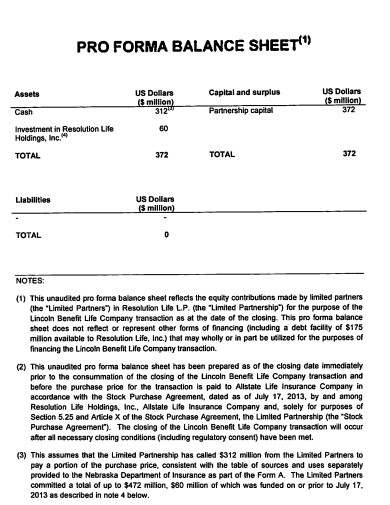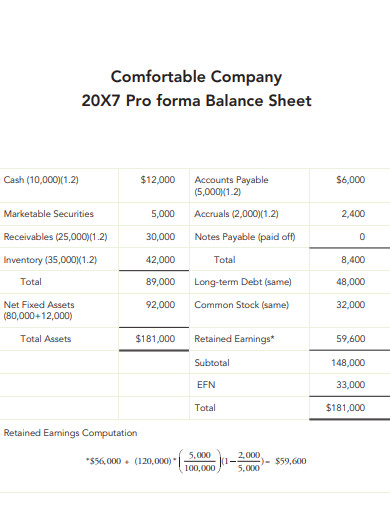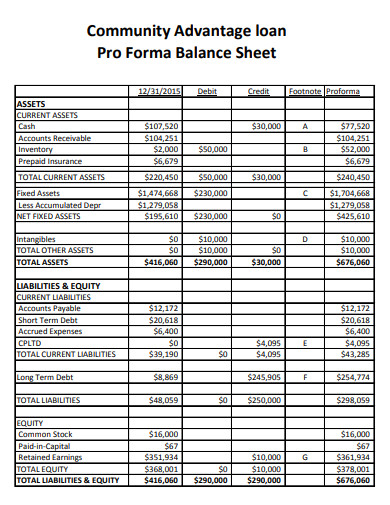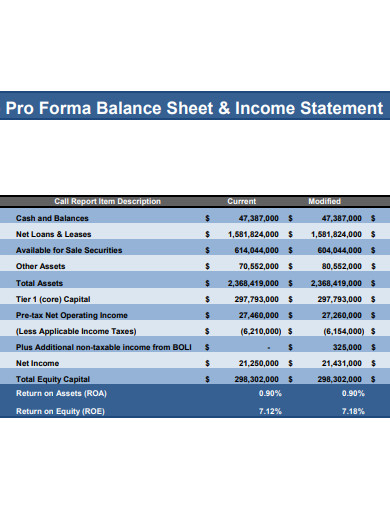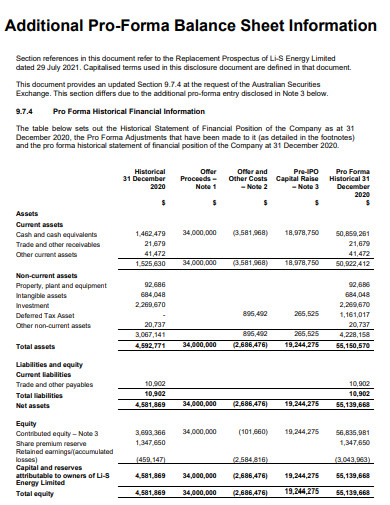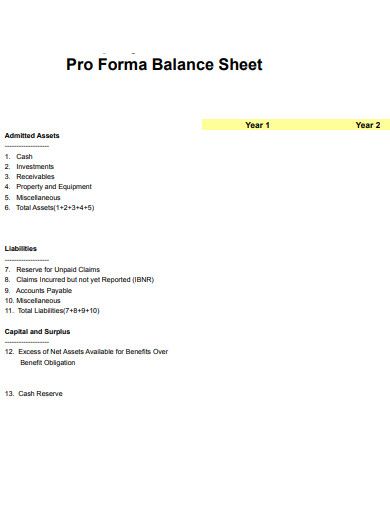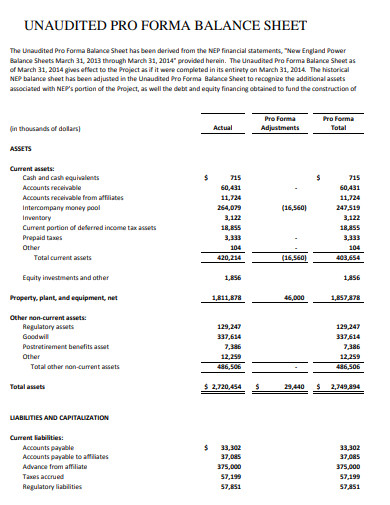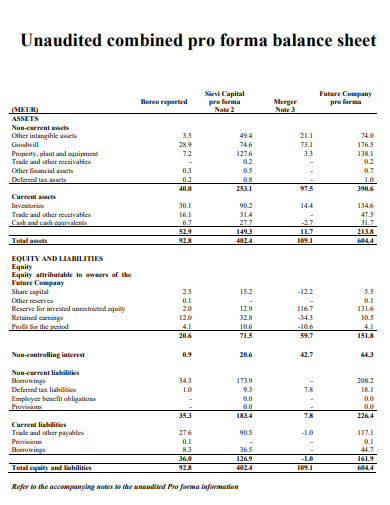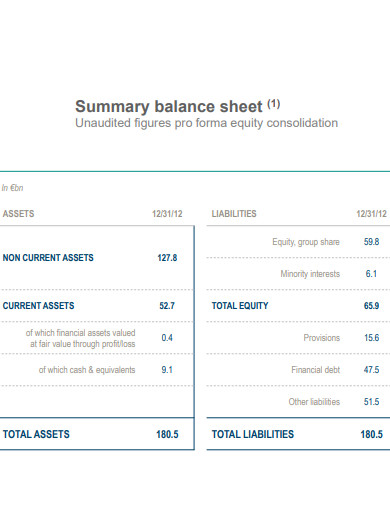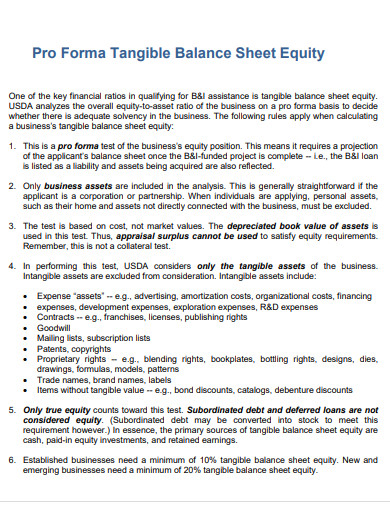In accounting, pro forma statements refer to the financial reports of a business based on hypothetical scenarios and enable an individual to test out situations they think might happen in the near future, enabling them to make a better and more informed business decision. The three major pro forma statements include the pro forma income statements, balance sheets, and cash flow statements. The pro forma statements are not required to comply with accounting standards. However, it must have a clear title of “pro forma” and businesses can not use it for filing taxes and other similar tasks.
10+ Pro Forma Balance Sheet Samples
1. Pro Forma Balance Sheet
2. Company Pro Forma Balance Sheet
3. Community Advantage Pro Forma Balance Sheet
4. Pro Forma Balance Sheet & Income Statement
5. Additional Pro-Forma Balance Sheet Information
6. Sample Pro-Forma Balance Sheet
7. Unaudited Pro-Forma Balance Sheet
8. Combined Pro-Forma Balance Sheet
9. Pro-Forma Summary Balance Sheet
10. Pro Forma Tangible Balance Sheet
11. 90 Day Pro Forma Balance Sheet
What is a Pro Forma Balance Sheet?
A pro forma balance sheet is one of the most important components of pro forma which provides a list of an individual or business’s future assets, liabilities, and stockholder’s equity written in the same format as their historical balance sheet. Startup companies can use this sheet to manage and plan their future assets while managers from more established companies enable them to make effective internal decisions. Pro forma balance sheets also serve as a tool for planning changes to the business like taking a loan, purchasing equipment, or purchasing another company.
How to Write a Pro Forma Balance Sheet?
Actual financial statements provide data on the business performance of a company in the past while pro forma financial statements projects how the company will perform in the future using theoretical scenarios. With a balance sheet, businesses can plan how to manage their assets for better results in the future. This document shows side-by-side comparisons of the investments made by the company, enabling it to come up with effective strategic planning according to those comparisons.
Step 1: Determine your Short Term Assets
The two items you need to include in your pro forma balance sheet are your current cash assets and accounts receivable. Your accounts receivable includes income from your source within the capability of the pro forma balance sheet which is based on your income at present and other factors such as paid receivable bills.
Step 2: Include your Long Term Assets
Your long-term assets can include buildings, land, and vehicles. The value of the building can be calculated by subtracting the current depreciation from the original purchase price and then multiplying it by the number of years it has been used. The land’s value does not experience depreciation so you won’t need to calculate its price.
Step 3: Provide your Estimated Total Liabilities and Costs
This includes all accounts payable, payroll, and other expenses that are within the range of the pro forma balance sheet. It also includes all mortgage payments.
Step 4: Create your Final Tabulations
The last step is creating your final tabulations. To determine whether you have enough to continue your operations, subtract your liabilities from your assets. It will also help you in determining whether to consider loan applications or not due to the lack of assets.
FAQs
What are the different types of pro forma financial statements?
The different types of pro forma financial statements include pro forma budget documents, pro forma company income statements, pro forma earning projections, pro forma financial accounting, and pro forma managerial accounting.
What are the types of pro forma statements?
The four main types of pro forma statements include a full-year pro forma projection, financing or investment pro forma projection, historical with acquisition pro forma projection, and risk analysis pro forma projection.
What is the importance of using pro forma balance sheets?
With pro forma balance sheets, small businesses or startup companies can manage and formulate a business plan for their future assets and liabilities and calculate their potential return on investment.
A pro forma balance sheet is a document that contains a company’s balance with its forecasted future values. It also includes all running balances for the assets, liabilities, and equity the business intends to acquire in the future. Pro forma financial statements are used by business owners, investors, creditors, and other decision-makers to measure the possible impact of their decisions on their businesses.
Related Posts
FREE 20+ Training Sheet Samples in PDF | MS Word
FREE 20+ Employee Sheet Samples in PDF | MS Word
FREE 10+ Employee Attendance Sheet Samples in PDF
FREE 12+ Balance Sheet Formats in MS Word | PDF | Excel
FREE 5+ Construction Bid Sheet Samples in PDF | MS Word | Excel
FREE 15+ Construction Timesheet Samples in PDF | MS Word
FREE 26+ Construction Sheet Samples in MS Word | Google Docs | Excel
FREE 20+ Continuation Sheet Samples in PDF | MS Word
FREE 25+ Program Sheet Samples in MS Word | Google Docs | Pages | PDF
FREE 33+ Student Sheet Samples in PDF | MS Word
FREE 32+ Planning Sheet Samples in PDF | MS Word
FREE 10+ OC Sheet Samples in PDF
FREE 10+ Beat Sheet Samples in PDF
FREE 3+ Paper Sign Up Sheet Samples in PDF
FREE 50+ Summary Sheet Samples in MS Word | Google Docs | Google Sheets | Excel | PDF

